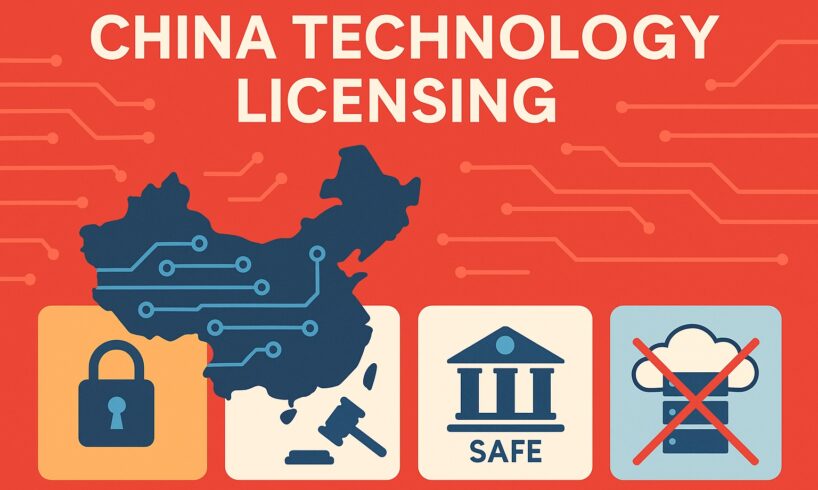
Why this guide and why now
Licensing to Chinese companies is surging. In the first half of this year, our law firm handled more China licensing agreements than in any prior full year. Buyers in China want technology, brands, data, and know-how to accelerate their product roadmaps. Sellers in the United States, Europe, and elsewhere want growth without the cost and risk of operating in China.
This guide shows how to do that without blowing up your IP, your compliance posture, or your leverage at the negotiating table.
The market reality in 2025
Many Chinese counterparties use licensed technology to launch mid-market offerings quickly, then reinvest revenue to move up the value chain. If you structure your China licensing deal correctly, you can capture real value while limiting leakage and competition risk.
Risks beyond the contract
Before you negotiate licensing terms, it is important you understand the macro risks that no contract can fully eliminate.
US–China political tensions. Technology licensing sits at the center of US–China strategic competition. Export controls tighten regularly; what’s exportable today may be restricted tomorrow. Sanctions lists expand without warning. If your deal depends on ongoing transfers of controlled technology, build in suspension and termination rights for regulatory changes. Don’t assume current rules will hold.
Sector-specific crackdowns. China’s regulatory approach shifts sector by sector, often suddenly. You should expect heightened scrutiny if your technology touches a sensitive sector, such as data collection, critical infrastructure, youth audiences, or information security.
State-owned enterprises (SOEs). Licensing to an SOE or state-affiliated entity adds complexity. SOEs operate with different approval chains, slower decision-making, and political considerations that can trump commercial logic. They’re harder to sue and harder to collect against.
Military–civil fusion concerns. China’s military–civil fusion strategy aims to transfer civilian tech to military applications. Screen carefully: check the Entity List, Unverified List, and Military End User List. Search English and Chinese names, plus affiliates and subsidiaries.
CFIUS for US companies. CFIUS primarily reviews foreign investments in US businesses. Pure outbound licensing without equity, board, or “control” rights is typically outside CFIUS. The real constraint on tech transfer is export controls. If a deal includes equity, board rights, access to sensitive personal data, or other investment-like hooks, talk to CFIUS counsel.
Practical posture. You can’t eliminate these risks, but you can structure for resilience. Keep core IP at home, stage technology transfers with reversible access, maintain alternate supply chains, and build contract provisions that let you suspend or exit cleanly when geopolitical or regulatory conditions shift.
The essential playbook: 10 steps before you sign
1) Map the technology
List everything you’re actually handing over: compiled code, source code, AI models, model parameters, training data, manufacturing processes, technical drawings, firmware, encryption keys, cloud access, and rights to future updates. Mark each item as export-controlled, commercially sensitive, or neither.
2) Clear export controls and sanctions
Check whether your technology, the intended use, the end users, and their locations trigger export restrictions. Document your legal basis (license required, license exception, or not controlled) and whether you need a government license.
3) Classify under China’s technology import/export rules
3. Classify under China’s technology import/export rules. China’s Ministry of Commerce (MOFCOM) maintains a catalog that puts technologies into three buckets:
Prohibited: Cannot be imported into China at all (rare for commercial tech)
Restricted: Can be imported but requires government approval before the contract takes effect and before banks and China’s State Administration of Foreign Exchange (SAFE) will clear outbound royalty remittances
Freely transferable: No special approvals required, though you may still need to register the contract for foreign-exchange purposes
Figure out which bucket your technology falls into. If it’s restricted, add 2–4 months for approval and plan for detailed Chinese-language technical documentation. Skip this and you’ll hit payment delays.
4) Run full counterparty diligence
Identify ultimate beneficial owners, group structure, subsidiaries and affiliates, and any list designations. Require a representation and covenant about ownership/control changes.
5) Protect territorial IP
File or confirm patents, trademarks, and copyrights in China with CNIPA before you license. Unregistered rights usually get you nowhere.
6) Define a narrow territory and fields
Use Mainland China if that is what you mean, and explicitly exclude Hong Kong, Macao, and Taiwan. Limit fields of use, product families, and channels. For software and cloud services, specify where users sit and where servers run – territory restrictions are meaningless for cloud services without technical controls (license servers, geofencing, hosting limits).
7) Engineer payment verifiability
Choose a royalty structure you can audit in practice, not just in theory, and align it with Chinese tax and foreign-exchange realities.
8) Lock down confidentiality and tech handling
Control who can access what, where data and servers sit, how keys are issued, how updates are delivered, and how logs are kept.
9) Choose dispute resolution you can enforce
Draft for enforceability in China. In many cases that means Chinese law, a Chinese-language controlling version, and arbitration with an enforceable seat (Hong Kong/HKIAC, Shenzhen/CIETAC or SCIA, or Singapore/SIAC are common). Hong Kong awards are generally enforceable in Mainland China under the Mainland–Hong Kong mutual enforcement arrangements.
10) Stage the deal
Use milestones, gated access, and reversible steps so you can stop the transfer cleanly if the counterparty shifts terms or misses obligations.
Diligence that actually catches problems
Corporate structure and affiliations
Do not stop at a business license. Build a tree of owners and subsidiaries. Confirm directors and legal reps. Check for government or military ties. Require prompt notice of changes.
Operational capacity
Make sure the licensee can actually use what they’re licensing. Ask how many engineers they have, what manufacturing facilities they control, what quality standards they follow, and what security certifications they hold. Companies that can’t execute often lead to reporting and audit problems.
Payments and tax posture
Ask how the counterparty has remitted royalties to foreign licensors before. Request the bank contact handling foreign exchange and the documentation they typically require. If they have no track record, assume friction and price it in.
IP registration and territory
Register patents, trademarks, and relevant copyrights in China before you license.
Real example. A US software company signed a license without first registering its trademark in China. Six months later, it discovered its licensee had applied for the mark and threatened to block the US company from using its own brand. Two years and significant legal fees later, the US company bought back its own trademark. Register first, license second.
Then spell out the exact territory. If you intend to grant rights only in Mainland China, say “the mainland of the People’s Republic of China (excluding Hong Kong, Macao, and Taiwan).” For cloud or digital products, define where users can be located and where servers must be hosted.
Royalty models that work in China
Fixed plus variable
Use a fixed annual minimum that justifies your support burden and protects you if reporting lags, plus a variable royalty on a simple and auditable base.
What to measure
Try not to base royalties on unit counts that you can only verify by flying to China and walking the factory floor. Use revenue recognized in the licensee’s audited financials for defined SKUs, or license-activation counts pulled from your own servers. For OEM/embedded tech, tie the base to ex-factory prices for designated products.
Audit mechanics
Give yourself audit rights with short notice, access to relevant books and records, and fee-shifting for material underpayment. Require system-level logs for software activations and updates. Define retention periods and the exact fields you can inspect. Reserve the right to communicate directly with the auditor where permissible under Chinese law.
Licensing contract architecture
Scope of license
Grant only what the licensee needs: limited, non-transferable, non-sublicensable unless expressly permitted, field-limited, territory-limited.
Delivery and updates
Tie delivery to milestones. Deliver hardened or older versions initially. For AI models, provide compiled or simplified versions. Don’t hand over the full trained model parameters unless that’s separately priced and controlled through gated milestones.
Confidentiality and trade secrets
Use definitions that Chinese courts will recognize and list exactly what’s confidential. Require access controls, named authorized personnel, training sessions, and certified destruction when the deal ends. Include preset damages for breaches you can prove and quantify. Chinese courts generally enforce these if the amount is reasonable and the breach is clear.
Open-source compliance
Don’t just trust their promises. Require a complete list of all open-source components they’re using, proof they’re following license terms, and a commitment not to mix your code with open-source components that would force you to disclose your source code.
Data, cybersecurity, and encryption
If personal data or systems that China considers critical infrastructure (think telecom, energy, finance, transport) might be involved, require the licensee to handle all local filings and approvals. China’s Cybersecurity Law, Data Security Law, and Personal Information Protection Law (PIPL) have teeth. Spell out who generates, stores, and rotates keys; where modules are hosted; and how you handle crypto-related filings.
Payment terms and FX
Define gross vs. net clearly. Allocate VAT and withholding. Require timely tax certificates and bank documents needed for remittance. Include a payment waterfall, acceptable banks, currency, and a fallback to escrow if remittance stalls for reasons not caused by you.
Dispute resolution
Arbitration typically works better than courts for enforcement of payments in China. Pick an institution with experience in tech disputes (CIETAC, SCIA, or HKIAC are common choices) and nail down the seat, language, and governing law. Seats in Hong Kong or Singapore (SIAC) are common for cross-border tech; Hong Kong awards are generally enforceable in Mainland China under the Mainland–Hong Kong mutual enforcement arrangements. If you go with courts instead, assume foreign court judgments won’t be recognized in China (and certainly not quickly), so if you need to chase assets or enforce an injunction there, you’ll likely need to sue in a Chinese court.
If rapid injunctive relief in China is critical to stop ongoing infringement, consider PRC court jurisdiction. Chinese courts can issue evidence and conduct preservation orders quickly.
Enforcement reality: why your contract is only part of the picture
Even a perfectly drafted contract enforced through arbitration won’t guarantee you get paid or can stop misuse.
Arbitration awards. Foreign arbitral awards issued by recognized institutions (HKIAC, SCIA, ICC, CIETAC) are generally enforceable in Chinese courts under the New York Convention and, for Hong Kong awards, the Mainland–Hong Kong mutual enforcement arrangements. Enforcement typically takes 6–18 months (contested cases can take longer) and requires filing where the defendant has assets.
Court judgments. If you win in a US, EU, or other foreign court, don’t expect Chinese courts to quickly—or necessarily ever—recognize or enforce your judgment.
Injunctions and IP enforcement. Chinese courts have become faster at preliminary injunctions in IP cases, particularly in Beijing, Shanghai, Shenzhen, and Hangzhou. Trademark and patent cases can move relatively quickly; trade-secret cases are harder and slower.
The real enforcement mechanisms. Your strongest leverage will often be business dependency. Structure your China licensing deal so the licensee needs ongoing access to updates, support, cloud services, component supplies, or certification to keep operating. If they breach, you cut them off. Technical controls enforced through license servers, authentication systems, and API keys are faster and more effective than litigation. The contract creates the legal framework; the technical architecture creates real-world compliance. We call these self-enforcing Chinese contracts, and these can be key.
Your enforcement strategy should assume you won’t sue. Design the business relationship and technical architecture so you don’t need to. Build in monitoring, control points, and reversible access. Make compliance easier than cheating. If you end up in arbitration or court, it’s because your initial deal structure failed.
Software-specific pitfalls
For software installed on the licensee’s servers, cap how many installations they can deploy, tie each license to specific hardware so they can’t just copy it to new machines, and build in logging that tells you when and where the software runs. For cloud or hybrid models, define where tenants reside and where processing occurs. Specify uptime and support obligations that match what you’re actually staffed to deliver. If you agree to put source code in escrow, only allow release for objective failures like bankruptcy or abandonment, not commercial disputes about support or pricing.
Hardware, firmware, and industrial tech
Specify exactly who can manufacture, where they can do it, and which sub-suppliers they can use. Require serialized components and traceability. Make them comply with relevant product standards and safety certifications. Reserve the right to audit manufacturing lines to confirm they’re protecting your firmware and encryption keys.
Joint ventures and “accidental” transfers
Many companies lose technology through joint ventures, pilot projects, or “co-development” deals that quietly shift your know-how into the partner’s systems. Treat every proof-of-concept or pilot as a mini-license: nail down the scope, deliverables, IP ownership, and whether they can reverse-engineer or benchmark your tech. Price co-development separately and reserve ownership of background IP and improvements unless fully compensated.
Pricing and value capture
Price everything you’re providing, not just the core license. Include training, localized documentation, integration support, and update streams as separate line items. Use step-ups for version changes, performance tiers, or additional product families. If the licensee wants exclusivity, insist on aggressive minimums, tight fields, and real termination rights when they miss.
Frequently asked questions on China licensing
Do I need to register my licensing agreement in China?
If royalties will cross the border, plan on filing something. Whether you must file or obtain approval depends on whether your technology appears in China’s catalogs for restricted or prohibited technologies. Restricted items generally require pre-approval before the contract takes effect and before payments start. Even when no approval is required, China’s foreign-exchange authority often asks for proof of contract filing to clear royalty remittances. Typical timelines run two to four months, longer if the local bureau is backlogged.
Should I use Chinese law and a Chinese-language controlling version?
If you will enforce in China, register the agreement, or satisfy local filings, using PRC law with a Chinese-language controlling version is usually the cleanest path. Always state clearly which language controls. If the deal uses a Chinese seat for arbitration, you will save time and money with a Chinese-only contract and proceedings.
How do I describe “China” correctly in the territory?
If you mean Mainland China only, write “the Mainland of the People’s Republic of China (excluding Hong Kong, Macao, and Taiwan).” For cloud or digital products, specify where users are located and where the service is hosted. Territory clauses alone do not police the internet; pair them with technical controls.
How do I keep my improvements and derivatives out of the grant?
Exclude improvements and derivative works from the baseline license. License them separately, tied to milestones, pricing, and approvals. For licensee-created derivatives using your tech, reserve rights of first negotiation or refusal, but do not give them away up front.
What happens if export-control or sanctions rules change after we sign?
Use a change-in-law clause that lets you suspend performance while you seek approvals or restructure. If the issue cannot be resolved within a defined period, for example 90 days, allow termination without liability for the blocked portion.
How do I verify the licensee is paying what they owe?
Design for verification. For software, use activation or usage telemetry tied to the license key. For hardware, use serial numbers and production reconciliation. Tie revenue reporting to audited financials, include short-notice audit rights with fee-shifting if variance exceeds an agreed threshold, and preserve the right to communicate directly with the auditor where permissible.
What if the counterparty stops paying or breaches?
Assume you will need operational leverage, not just a lawsuit. Keep the ability to withhold updates, suspend cloud access, turn off API keys, stop component supply, or pause certifications and support for non-payment or material breach. Your enforcement plan should not rely solely on litigating in China.
Do I need to worry about taxes and getting paid in foreign currency?
Royalty remittances from China typically face withholding income tax (often around 10 percent under domestic law, potentially reduced by treaty) and may trigger VAT and surcharges depending on the royalty type and use location. Banks will require supporting documents such as the contract, invoices, and proof of filing or registration to clear foreign-exchange review. Decide who bears taxes, who issues fapiao, the currency (RMB vs. USD), and the payment route and schedule in the agreement.
Can the Chinese licensee sublicense or manufacture with third parties?
Do not assume. Say whether sublicensing is allowed, in what fields, and with what approval process. If third-party manufacturing is contemplated, require named vendors, quality controls, traceability, audit access, and IP undertakings down the chain.
What dispute resolution should I use?
Arbitration is common for cross-border tech licenses. Pick one seat and one language. If you expect China-side filings and enforcement, a China-seated arbitration in Chinese is pragmatic. If your counterpart will honor a foreign award and you prefer English, consider Vancouver, Singapore, or Hong Kong. Avoid dual-language arbitration (proceedings conducted simultaneously in two languages); it multiplies cost and risk
Do I need to localize the contract or the product for Chinese law and data rules?
If the product touches personal data or critical infrastructure, expect PRC data, cybersecurity, and localization requirements to apply. Bake compliance obligations into the license: who hosts, where data sits, who handles requests, and what certifications are required. If arbitration will be in Chinese or filings are needed, maintain a Chinese contract version that actually matches the English. If you touch personal data of individuals in China, China’s Personal Information Protection Law (PIPL) may impose purpose limitation, minimization, and cross-border transfer assessments.
How do I stop parallel exports or off-territory sales?
Combine contractual restrictions with operational controls: serials keyed to territory, geofenced services, packaging or label variants, and channel reporting. Require the licensee to police its distributors, report breaches, and accept liquidated damages for willful diversion.
What should the royalty clause actually say?
Define the base, for example net invoiced sales to unrelated customers. List permitted deductions narrowly, fix the rate and any tiering, state the currency, payment timing, late interest, minimums or advances, reporting cadence, and audit terms. Prohibit transfer-pricing games and related-party sales below market.
Should I record my IP in China first?
Yes. Register relevant trademarks, patents or designs, and copyrights in China right away. Contract rights are not a substitute for registrations, and enforcement without them is slow and uncertain.
Conclusion
By adopting robust negotiation strategies, ensuring rigorous contractual protections, and adhering to the regulatory requirements, you can effectively manage the risks and leverage the opportunities of licensing your technology to China.
If you’re evaluating a China licensing deal, the most valuable thing you can do is map your specific risks before you’re deep in negotiations. We’ve built a rapid assessment process that typically takes a week and gives you a clear picture of export control issues, IP gaps, payment friction points, and leverage risks in your draft terms.
If you want to talk through your situation, reach out. No need to send anything formal—just a quick description of what you’re licensing and who you’re talking to. We’re happy to point you in the right direction, whether that means working together or not.





